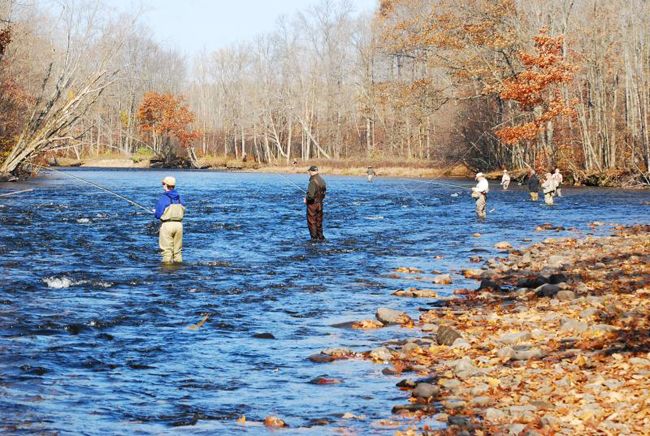
Fishers on the Salmon River, a tributary to Lake Ontario. Photo: David Chanatry, NYD Reporting Project
Oswego, NY, March 18, 2014 - Lake Ontario is boasting some of the best sport fishing among the Great Lakes, thanks to a successful stocking program by New York state's environmental management agency.
The Department of Environmental Conservation pumps ample supplies of trout and salmon into Lake Ontario and its tributaries every year. It attracts anglers from all over — more than 2.5 million each season.
The health of Lake Ontario and the Great Lakes has been steadily improving since the 1970s, when they were nearly an ecological disaster, according to Dave MacNeill, a fisheries specialist with New York Sea Grant.
"As improvements in water quality occurred, a sea lamprey control program began and stocking of trout and salmon really took hold, creating a multimillion dollar industry and perhaps the best of any of the fisheries in the Great Lakes," he said.
This audio clip is from a discussion on WRVO radio. Based in Oswego, NY, WRVO Public Media is a part of the National Public Radio digital network.
If you don't see the player above, it's because you're using a non-Flash device (eg, iPhone or iPad). You can download the mp3 file by clicking here (mp3). It may take a few minutes to download, so please be patient.
Not all of those fished stocked in Lake Ontario are native, but "it's a bit of a juggling act" between a historically native lake with what can survive today, said Steve LaPan of the DEC's fisheries research station.
"Overall, there are some negative aspects of stocking non-native fish," he said. "But I think if you look at the way the lake is functioning ecologically and the economic benefits along the lakeshore are enjoying, I’d say it’s highly successful."
The economic impact of the sport fisheries industry translates to $113 million each year for communities along the lake, according to the DEC's most recent survey, done in 2007. LaPan says it's remained steady in recent years.
The DEC will hold its final "state of Lake Ontario" informational meeting this evening in Pulaski. It begins at 7 p.m. at the DEC's Training Academy, 24 County Route 2A.
New York's trout and salmon fishing season begins April 1.
More Info:
New York Sea Grant (NYSG), a cooperative program of Cornell University
and the State University of New York, is one of 33 university-based
programs under the National Sea Grant College Program (NSGCP) of the
National Oceanic and Atmospheric Administration (NOAA). The NSGCP
engages this network of the nation’s top universities in conducting
scientific research, education, training and extension projects designed
to foster science-based decisions about the use and conservation of our
aquatic resources. Through its statewide network of integrated
services, NYSG has been promoting coastal vitality, environmental
sustainability, and citizen awareness about the State’s marine and Great
Lakes resources since 1971.
For updates on Sea Grant activities: www.nyseagrant.org has RSS, Facebook, Twitter, and YouTube links. NYSG also offers a free e-list sign up via www.nyseagrant.org/coastlines for NY Coastlines, its flagship publication, which merged with our e-newsletter, Currents, in 2014 - is published several times a year.